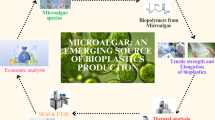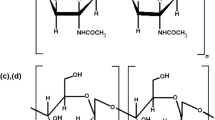Abstract
For selecting a suitable culture period during bioreactor culture of Orostachys cartilaginous cells, the kinetics of cell biomass and bioactive compound accumulation were investigated. Cell biomass accumulation had a typical lag phase from 0 to 5 days, an exponential phase from 10 to 25 days, and an obvious declining phase from 25 to 30 days. Total polysaccharide and phenolic accumulation was synchronized with cell growth; their maximum contents were observed at 25 days. Among the flavonoids, quercetin (Qc) and kaempferide (Ke) reached maximum levels at 20 days, whereas the epicatechin gallate (Ecg), quercetin 3-O-glucoside (Qc-3-glc), and kaempferol-3-O-rutinoside (Kp-3-rut) content peaked at 25 days. The suitable culture period of 25 days was confirmed by majority of the observed bioactive compound accumulation. The effect of the air volume was also studied. The cell biomass accumulation was optimal at an air volume of 150 ml min−1. However, the highest content for different bioactive compounds was determined at the varied air volume, i.e., total polysaccharides, total phenolics, and total flavonoids at an air volume of 150 ml min−1, flavonoid monomers of Kp-3-rut at 100 ml min−1, Ke and Ecg at 150 ml min−1, Qc and Qc-3-glc at 200 ml min−1. However, the maximum productivity for all bioactive compounds was at the air volume of 150 ml min−1. The O. cartilaginous cell cultures had higher antioxidant properties. The cell extract concentration providing 50% of 1,1-diphenyl-2-picrylhydrazyl and alkyl radical-scavenging activity were 0.0487 and 0.11 mg ml−1, respectively. Therefore, the bioreactor-cultured cells of O. cartilaginous can be used as potential material sources for production of desirable bioactive compounds and products of O. cartilaginous.







Similar content being viewed by others
Abbreviations
- MS:
-
Murashige and Skoog
- BA:
-
Benzylaminopurine
- NAA:
-
α-Naphthalene acetic acid
- FW:
-
Fresh weight
- DW:
-
Dry weight
- μ :
-
Specific growth rate
- T d :
-
Doubling time
- Qc:
-
Quercetin
- Ke:
-
Kaempferide
- Ecg:
-
Epicatechin gallated
- Qc-3-glc:
-
Quercetin 3-O-glucoside
- Ke-3-rut:
-
Kaempferol-3-rutinoside
- HPLC:
-
High-performance liquid chromatography
- DPPH:
-
1,1-Diphenyl-2-picrylhydrazyl
- ESR:
-
Electron spin resonance
- SE:
-
Standard error
References
Ahmad S, Hahn EJ, Paek KY (2008) Aeration volume and photosynthetic photon flux affect cell growth and secondary metabolite contents in bioreactor cultures of Morinda citrifolia J. Plant Biol 51:209–212
Ali MB, Yu KW, Hahn EJ, Paek KY (2005) Differential responses of antioxidant enzymes, lipoxygenase activity, ascorbate content and the production of saponins in tissue cultured root of mountain Panax ginseng C.A. Mayer and Panax quinquefolium L. in bioreactor subjected to methyl jasmonate stress. Plant Sci 169:83–92
Dubois M, Gilles KA, Hamilton JK, Rebers PA, Smith F (1956) Colorimetric method for determination of sugars and related substances. Anal Chem 28:350–356
Je M, Jung WJ, Lee KY, Kim YC, Sung SH (2009) Calpain inhibitory flavonoids isolated from Orostachys japonicus. J Enzyme Inhib Med Chem 24:676–679
Jiang YJ, Piao XC, Liu JS, Jiang J, Lian ZX, Kim MY, Lian ML (2015) Bioactive compound production by adventitious root culture of Oplopanax elatus in balloon-type airlift bioreactor systems and bioactivity property. Plant Cell Tiss Organ Cult 123:413–425
Jin DH, Kim HS, Seong JH, Chung HS (2016) Comparison of total phenol, flavonoid contents, and antioxidant activities of Orostachys japonicus A. Berger extracts. J Environ Sci Int 25:695–703
Kim WJ, Jung HY, Min JY, Park DJ, Kim YD, Kang YM, Choi MS (2004) Effects of growth regulators on shoot regeneration and polysaccharide production of Orostachys japonicus Berger. Kor J Med Crop Sci 12:391–396
Lee JH, Lee SJ, Park S, Kim HK, Jeong WY, Choi JY, Sung NJ, Lee WS, Lim CS, Kim GS, Shin SC (2011) Characterisation of flavonoids in Orostachys japonicas A. Berger using HPLC-MS/MS: contribution to the overall antioxidant effect. Food Chem 124:1627–1633
Lee SJ, Kim EK, Kim YS, Hwang JW, Lee KH, Choi DK, Kang H, Moon SH, Jeon BT, Park PJ (2012) Purification and characterization of a nitric oxide inhibitory peptide from Ruditapes philippinarum. Food Chem Toxicol 50:1660–1666
Lee HS, Lee GS, Kim HS, Kim HK, Suk DH, Lee DS (2014) Anti-oxidizing effect of the dichloromethane and hexane fractions from Orostachys japonicus in LPS-stimulated RAW 264.7 cells via upregulation of Nrf2 expression and activation of MAPK signaling pathway. BMC Rep 47:98–103
Li M, Hirata Y, Xu G, Niwa M (1990) Determination of polysaccharide contents in the drugs of Dendrobium. Chin Tradit Herb Drugs 21:10–12
Li W, Ding Y, Quang T, Thanh NT, Sun YN, Yan XT, Yang SY, Choi CW, Lee EJ, Paek K, Kim YK (2013) NF-κB inhibition and PPAR activation by phenolic compounds from Hypericum perforatum L. adventitious root. Bull Korean Chem Soc 34:1407–1413
Li QW, Hou DM, Liang MQ, Liu RN (2014) Construction of rapid propagation system for Orostachys fimbriatus. Acta Agricult Zhejiangensis 26:84–88
Li CF, Wang SH, Li DH (2015) Antioxidant activities from Orostachys cartilaginous extracts. Food Sci Technol 40:285–288
Li H, Piao X, Gao R, Jin M, Jiang J, Lian M (2016) Effect of several physicochemical factors on callus biomass and bioactive compound accumulation of R. sachalinensis bioreactor culture. In Vitro Cell Dev Biol-Plant 52:241–250
Meijer JJHH, Libbenga KR (1993) Effects of hydrodynamic stress on cultured plant cell: a literature surve. Enz Microb Technol 15:234–238
Murashige T, Skoog F (1962) A revised medium for rapid growth and bioassays with tobacco tissue cultures. Physiol Plant 15:473–497
Murthy HN, Lee EJ, Paek KY (2014) Production of secondary metabolites from cell and organ cultures: strategies and approaches for biomass improvement and metabolite accumulation. Plant Cell Tiss Organ Cult 118:1–16
Nanjo F, Goto K, Seto R, Suzuki M, Sakai M, Hara Y (1996) Scavenging effects of tea catechins and their derivatives on 1, 1-diphenyl-2-picrylhydrazyl radical. Free Radic Biol Med 21:890–895
Park HJ, Moon SH, Kim JO, Lee SH, Choi JS (1991) A study on the chemical constituents of Orostachys japonicus A. Berger. Kor J Pharmacogn 22:78–84
Peng XY, Xiong YL, Kong BH (2009) Antioxidant activity of peptide fractions from whey protein hydrolysates as measured by electron spin resonance. Food Chem 113:196–201
Qi Y, Wang S (2007) Bioreaction dynamics and bioreactor. Chemical Industry Press, Beijing
Ramachandra RS, Ravishankar GA (2002) Plant cell cultures: chemical factories of secondary metabolites. Biotechnol Adv 20:101–153
Schlatmann J, Moreno P, Selles M, Vinke J, Hoopen H, Verpoorte R, Heijnen J (1995) Two-stage batch process for the production of ajmalicine by Catharanthus roseus: the link between growth and production stage. Biotechnol Bioeng 47:53–59
Singleton V, Orthofer R, Lamuela-Raventos R (1999) Analysis of total phenols and other oxidation substrates and antioxidants by means of folin-ciocalteu reagent. Methods Enzymol 299:152–158
Thanh NT, Murthy HN, Paek KY (2014) Optimization of ginseng cell culture in airlift bioreactors and developing the large-scale production system. Ind Crops Prod 60:343–348
Wang G, Qi NM, Wang Z (2010a) Application of a stir-tank bioreactor for perfusion culture and continuous harvest of Glycyrrhiza inflata suspension cells. Afr J Biotechnol 9:347–351
Wang J, Gao W, Zhang J, Huang T, Cao Y, Zhao Y (2010b) Dynamic change of metabolites and nutrients in suspension cells of Panax quinquefolium L. in bioreactor. Acta Physiol Plant 32:463–467
Wang J, Zhang J, Gao WY, Wang Q, Yin SS, Liu H, Man SL (2013) Identification of triterpenoids and fl avonoids, step-wise aeration treatment as well as antioxidant capacity of Glycyrrhiza uralensis Fisch. cell. Ind Crops Prod 49:675–681
Zhang C, Dong Y, Li Y, Fu C, Zhao C, Yu L (2013) Unstructured models for suspension cultures of Taxus media cells in a bioreactor under substrate-sufficient conditions. Biochem Eng J 71:62–71
Zhong JJ, Zhu QX (1995) Effect of initial phosphate concentration on cell growth and ginsenoside saponin production by suspension culture of Panax notoginseng. Appl Biochem Biotechnol 55:241–247
Zhong JJ, Yoshida M, Fujiyama K, Seki T, Yoshida T (1993) Enhancement of anthocyanin production by Perilla frutescens cells in a stirred bioreactor with internal light irradiation. J Ferment Bioengr 75:299–303
Acknowledgements
This research was supported by the National Natural Science Foundation of China (31660080 and 31260182).
Author information
Authors and Affiliations
Corresponding author
Additional information
Communicated by H. Peng.
Rights and permissions
About this article
Cite this article
Piao, XC., Zhang, WB., Jiang, J. et al. Cell suspension culture of Orostachys cartilaginous in bioreactor systems for bioactive compound production and evaluation of their antioxidant properties. Acta Physiol Plant 39, 70 (2017). https://doi.org/10.1007/s11738-017-2374-0
Received:
Revised:
Accepted:
Published:
DOI: https://doi.org/10.1007/s11738-017-2374-0




